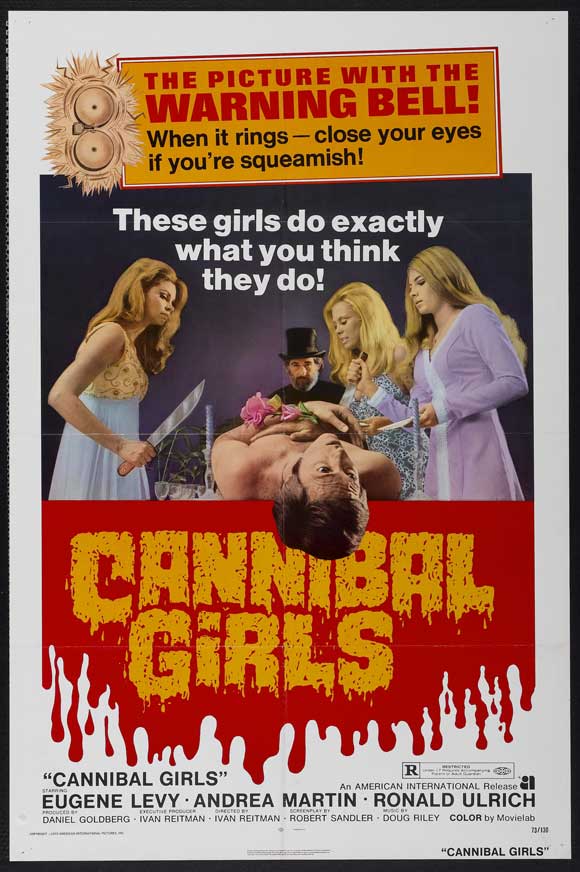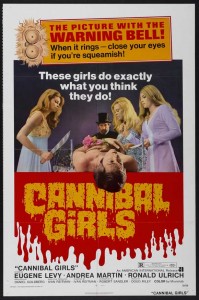Shot in 1972 by a then-unknown filmmaker Ivan Reitman, Cannibal Girls may not have been the first Canadian horror film ever made, but it quickly gained a reputation as one of the sleaziest Canadian B-movie concoctions of its era. Where previous attempts at horror in Canadian cinema had largely been sober affairs like the blood and sex-free Reincarnate or Catholicism-driven Quebecois efforts like The Pyx, Cannibal Girls took its pulpy cues from drive-in fare south of the border and delivered a more visceral experience to audiences. A purposely trashy and surreal tale of a couple that has a run-in with some blood-hungry honeys in an isolated small town community, the film was an important harbinger of things to come for a young Canadian film industry still grappling with its own identity. The country’s first big international B-movie hit, it set new standards of depravity (and comedy!) and served an important incubation ground for both Reitman, who would become one of Hollywood’s most sought-after talents in the wake of 1984’s Ghostbusters, and future SCTV performers Andrea Martin and Eugene Levy, both appearing in their first major feature film role.
The movie follows Cliff (Levy, sporting an impressive afro and moustache combo) and his new girlfriend Gloria (Martin), who are stranded in snow-bound Farnhamville after their car breaks down. While waiting for the run-down service station, the pair decide to crash at a local motel. There, the owner tells them of the town legend, about a trio of young girls who would bring men home to kill them and eat their remains. Since that dark period, the house where the girls once satisfied their unnatural desires has become a fancy local eatery.
Fascinated and slightly repulsed, Cliff and Gloria nevertheless decide to head to the town’s most infamous address for dinner. The only customers of the night, they are welcomed by the mysterious proprietor Reverend Alex St. John (Ronald Ulrich), who regales them with more grisly local stories as three familiar-looking waitresses serve their meals. The meal is wonderful, even if the company is somewhat awkward, but the meal goes so long that the Reverend suggests the couplespend the night in the house, despite Gloria’s protests and insistence that something is quite wrong with the whole creepy set-up.
Turns out Gloria had good reason to worrybefore long, the Reverend enters their bedroom with his three girls in tow. Cliff is quickly chained to the bedposts, and the Reverend attempts to hypnotize Gloria to kill her boyfriend with a knife. Mortified, she escapes and manages to hitch a ride with a doctor, who gives her a sedative and promises to take care of her. When Gloria awakens, she is back in her motel bed with Cliff. She suddenly realizes that her harrowing experience at the house was nothing but a bad dream… or was it?
Even before Cannibal Girls, Reitman and his film partner Dan Goldberg had become infamous names in Canadian cinema circles for their daring student feature The Columbus of Sex, which landed the pair in the Ontario courts over obscenity charges (which were eventually dropped). After securing CFDC funding, the partners made a sexy college comedy follow-up Foxy Lady, but it was a mostly unsatisfying experience that encouraged Reitman and Goldberg to set their sights on the lucrative horror market, from which many enthusiastic young directors graduated to mainstream filmmakers. Shot for only $12,000 with a vague premise and largely improvised dialogue, Cannibal Girls is a fun little exercise in Canadian horror even though it doesn’t stand up to much scrutinythe story is frequently confusing, the acting sometimes suspect, and the extended dream sequence plot twist discouraging. While some of this can probably be attributed to the extensive re-shoots Reitman and Goldberg decided were needed to flesh out the story, there’s no denying that Cannibal Girls is a quintessential example of 1970s grindhouse cinemamessy, amateurish, crude and not afraid to wallow in its sleazy subject matter.
What’s most notable, however, is that the film is frequently laugh-out-loud funny. There’s a noticeable vein of dark humour running throughout, as a pre-SCTV Eugene Levy and Andrea Martin manage riff off of each other as the young couple that can’t seem to catch a break, but their performances are largely deadpan, such as when Levy awkwardly impales a cigarette to the loose end of a guitar string, or Martin coaxes the stalled car back to life by telling it how much she loves it. The humorous bits don’t fully blend in well with the sleazier horror aspects of the premise, resulting in a sometimes unsure tone, but the seeds of Reitman’s spooky humour are evident. Much more interesting is Ronald Ulrich’s unsettling, sometimes campy turn as the Reverend. A charismatic Svengali in a top hat, cape and gloves, the Reverend is part Charles Manson and part Vincent Price, and is fond of quoting Shakespeare and vaguely demonic poetry. Imposing pictures of him are seen all around town, hovering over kitchen tables as the locals chow down on large hunks of raw meat and comment on the taste of human flesh as though they were discussing fine cuisine. Also keep an eye out for Fishka Rais, better known as Igor on the Hilarious House of Frightenstein, who has a short cameo as a deli owner.
Despite its lurid title, Cannibal Girls is not as drenched in the red stuff as most viewers might expect. The bloodshed never gets more gruesome than in one flashback sequence of the girl’s earlier flesh-eating fun, in which one man is chained to the bed while the girls pour blood over his chest and proceed to eat him alive. This lack of solid spectacle turned out to be a major problem for the picture when it was picked up for distribution by American International Pictures, home of schlock king Roger Corman. Unsure of what to do with the bewildering and bizarre picture, a special “warning buzzer” gimmick was added which was heavily advertised in the film’s advertising campaign (in fact, the trick was “borrowed” from 1966’s Chamber of Horrors) . The gimmick worked like this: before a scene of potentially squeamish fun,a buzzer would go off, and easily-upset members of the audience would know to close their eyes until a doorbell sound indicated the surely indescribable horror was over. The William Castle-style ballyhoo obviously made an impression on some, including teenager Lawrence Zazalenchuk, who copied it for his Sudbury-shot gore effort The Corpse Eaters the following year.
But The Corpse Eaters wasn’t the only film intent on imitating Cannibal Girls’ makeshift ode to the box office power of boobs and blood. By looking beyond our borders and gaining U.S. distribution, the film once again opened up international market to budding Canadian shlockmeisters in a way that hadn’t been achieved with 1963’s The Mask, the first Canadian B-movie to make a splash outside of the country when it was scooped up by Warner Brothers. Similar exploitation films like Deranged, Shivers and Death Weekend followed almost immediately, the latter two even produced by Reitman, who had since hooked up with the likeminded masterminds at Cinepix, John Dunning and Andre Link. While arguable not as successful as these later films, Cannibal Girls nevertheless did pave the way for a more lurid brand of Canadian B-cinema, one that was, for a while, unquestionably supported by the government’s film programs.
Another unique aspect of Cannibal Girls is that it is an unabashedly Canadian film that is actually set where it was filmed. A University of Toronto sticker and a maple leaf flag are clearly seen, and the dialogue specifically references Toronto on at least one occasion. The Toronto suburb of Richmond Hill stands in for the fictional Farnhamville, and the film plays on the terror of small town isolation that is part of most Canadians’ upbringings. When Cliff and Gloria discover the breadth of the community-wide conspiracy of cannibalism, there’s simply no escape without access to a carthey are destined to remain part of the terrifying town forever, in the clutches of the Reverend’s vampire-like cabal of bloodthirsty killers. Reitman also makes the most out of his snowy locale to strand the couple and then heighten their claustrophobiain fact, Cannibal Girls was the first snowbound Canadian horror ever made, and is topped only by The Ghostkeeper’s use of the frozen landscape as a source of despair and loneliness.
Despite some obvious problems, Cannibal Girls remains a true slice of vintage Canadian B-cinema that holds up better than many of the more restrained horror efforts that preceeded it. Harkening a new age of unabashed exploitation in Candaian cult filmmaking, it’s a landmark effort that remains essential viewing for Canuxploitation fans who, despite the film’s rarity, already know that these girls “do EXACTLY what you think they do!”
Foundational Cinema
Copyright © 2025 The B Movie Nation


